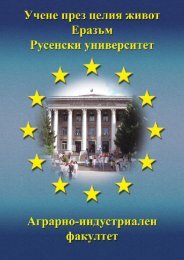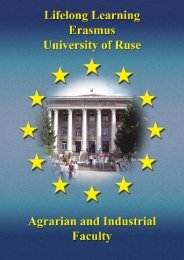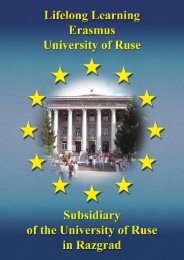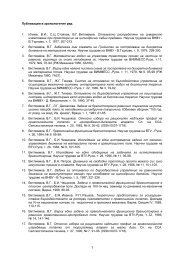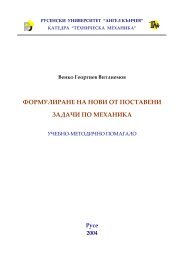Erasmus ECTS Information Package
Erasmus ECTS Information Package
Erasmus ECTS Information Package
You also want an ePaper? Increase the reach of your titles
YUMPU automatically turns print PDFs into web optimized ePapers that Google loves.
<strong>Erasmus</strong> <strong>ECTS</strong> <strong>Information</strong> <strong>Package</strong><br />
Faculty of EEEA<br />
3110 Communication Circuits<br />
ЕСТS credits: 5<br />
Weekly classes: 2lec+0sem+0labs+2ps+1cw<br />
Assessment: exam<br />
Type of exam: written and oral<br />
Department involved:<br />
Department of Telecommunications<br />
Faculty of Electrical Engineering, Electronics and Automation<br />
Lecturers:<br />
Assoc. Prof. Tanya Metodieva Stoyanova; Meng, PhD, Dept. of Theoretic and Measuring Engineering,<br />
tel.: 888 502, E-mail: tstoyanova@uni-ruse.bg;<br />
Principal Assistant Professor Adriana Naydenova Borodzhieva, MEng, Dept. of Telecommunications,<br />
tel.: 888 734, E-mail: aborodjieva@ecs.uni-ruse.bg.<br />
Abstract:<br />
The Communication Circuits course familiarizes the students with the most frequently used communication circuits<br />
and systems and the main methods for their analysis and design. It also deals with resonant circuits and electrical<br />
filters as well as with different types of modulation and some modulator implementations, too. The acquired<br />
knowledge serves as a basis for all specialized courses of the programme.<br />
Course content:<br />
Resonant circuits. Series-resonant circuits and parallel-resonant circuits. Coupled circuits and tuning coupled<br />
circuits.<br />
Electrical filters – low-pass, high-pass, band-pass and band-stop. Reactive filters – LC filters of type “K” and type<br />
“m” – series-derived and parallel-derived. Passive and active RC filters. Approximation of amplitude responses<br />
and phase responses.<br />
Modulations. Amplitude modulation. Angular modulation – frequency modulation and phase modulation. Pulse<br />
modulations – pulse-amplitude modulation, pulse-time modulation, pulse-coded modulation.<br />
Teaching and assessment:<br />
Lectures present the course material according to the syllabus. During the practical classes students solve<br />
problems covering the topics of the syllabus. Continuous assessment is conducted at the practical exercises<br />
through written tests. At the beginning of the semester each student is given an individual problem as a course<br />
assignment. It has to be presented at the end of the semester in written form and is defended orally. Final<br />
assessment is accomplished via an exam, conducted in written and oral form.<br />
3111 Course Project on Pulse and Digital Devices<br />
<strong>ECTS</strong> credits: 2<br />
Weekly classes: 0lec+0sem+0labs+0ps+3cp<br />
Assessment: defence<br />
Type of exam: oral<br />
Department involved:<br />
Department of Telecommunications<br />
Faculty of Electrical Engineering, Electronics and Automation<br />
Lecturers:<br />
Assoc. Prof. Nina Vasileva Bencheva, MEng, PhD, Dept. of Telecommunications, tel.: 888 823, 888 677<br />
E-mail: nbencheva@ecs.uni-ruse.bg<br />
Assoc. Prof. Yoana Emilova Ruseva, MEng, PhD, Dept. of Telecommunications, tel.: 888 823, 888 677,<br />
E-mail: iruseva@ecs.uni-ruse.bg<br />
Principal Assistant Professor Volodia Hristov Tsonev, MEng, Dept. of Telecommunications, tel.: 888 677,<br />
E -mail: vol@uni-ruse.bg<br />
Abstract:<br />
The objective of the Pulse and Digital Devices course project is to consolidate the students’ knowledge about<br />
basic problems in digital electronics. The main idea is to connect the functions of the digital elements with their<br />
microelectronic basis on one hand, and on the other hand – with their application when building pulse and digital<br />
devices. The course project utilises the acquired knowledge of the subject with the same name. The acquired<br />
knowledge is used in the specialist subjects in the field of digital engineering.<br />
Course content:<br />
The course project consists of two parts. A definite digital device without memory is designed with assigned<br />
element base set in the first part. The calculated logical functions are minimized and a structural device scheme is<br />
made. With assigned external characteristics and parameters of a pulse device, the digital elements are chosen,<br />
the parameters and logic functions are analyzed and some pulse and digital circuits are designed in the second<br />
part.<br />
Teaching and assessment:<br />
The course project is done by the students independently. Individual assignments for the first part are given at the<br />
beginning of the semester and after they have been accomplished (by the 7th week), individual assignments are<br />
given for the second part. During the semester students can attend weekly tutorials. The defence of each part of<br />
the course project is done orally and suggested scheme solutions are substantiated.<br />
194



